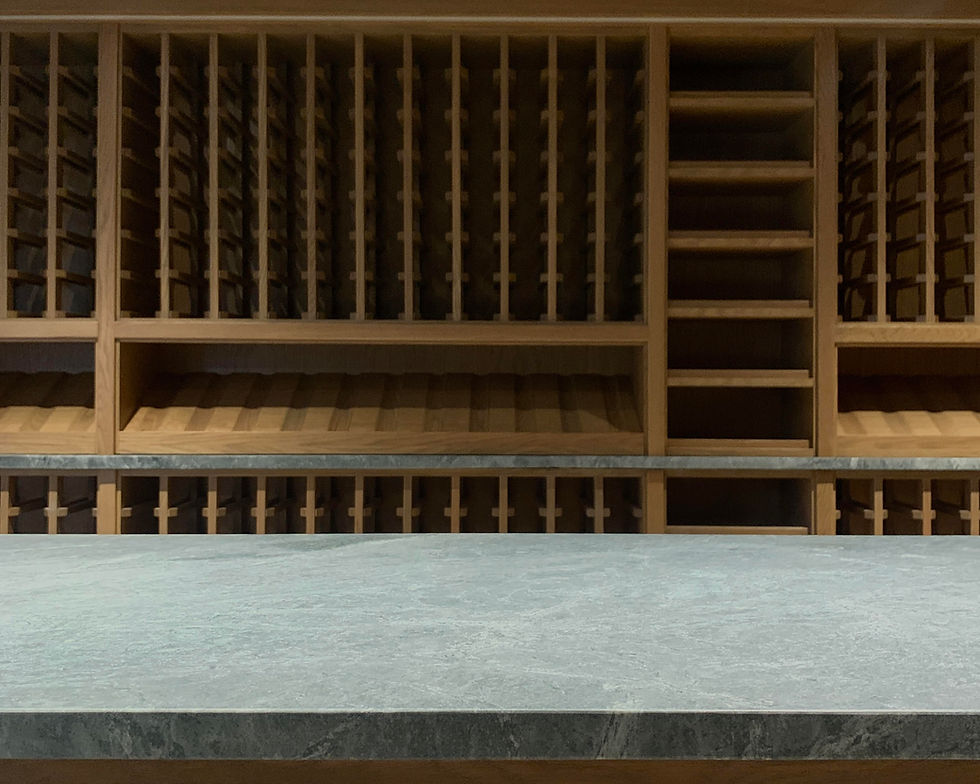Ah, soapstone: marble’s earthy-crunchy, do-it-yourself, perfectly imperfect cousin. Cloaked in mystique, this mineral-based stone has always been a niche fan-favorite… but not for the reasons you might think. Its popularity in many industrial, rugged, or naturalist designs is owed much to the fact that it is a stone with a story, accumulating characteristic imperfections and developing a patina over time that shows its aging with grace in the ways only nature can. But while it is a natural stone, it sets itself apart from the rest of the family in several key ways that are important to be aware of before leaping to any decisions. Let’s jump in and take a look…
What is soapstone?
Soapstone is a natural stone composed primarily of talc. Geologically speaking, there are specific parameters that separate soapstone from serpentine and other similar minerals. In the world of countertops, however, it’s classified as a rugged material that’s softer than marble, ranging from 1-4 on the Mohs hardness scale. Softer varieties are used for stone carving, while harder ones are what we typically use for commercial surfaces. Fun fact: Cristo Redentor (or Christ the Redeemer) in Rio de Janeiro is carved from soapstone!
How is it different from other natural stones?
As we mentioned before, soapstone falls under the natural stone family, but doesn’t follow many of the same rules or carry the same traits as others like marble, granite or quartzite. So how is it different?
It’s softer. Soapstone is predominantly composed of talc. Each type varies in softness depending on how much talc is present in the stone.
It’s non-porous. Unlike granite, marble or quartzite, soapstone’s porosity is virtually zero. Since it won’t absorb moisture or stains, there is no need to seal soapstone.
No etching. Soapstone is unaffected by acidic substances, so there is no risk of chemical abrasion to the stone. Again… no sealing necessary!

Barroca soapstone. Photo by Alyssa Powers.
What are the benefits?
It’s nonporous. As previously mentioned, soapstone will not absorb liquids, making it a naturally stain-resistant surface.
It won’t etch. Also previously mentioned, soapstone is highly resistant to chemical abrasion, so it won’t etch like other stones.
Naturally sanitary. Because its porosity is nearly zero, soapstone will not harbor bacteria.
High heat resistance. Throw your hot pans and dishes on the counters without fear of scorching. (Yes, we still recommend a trivet for maximum protection.)
Unique appearance and texture. For many people, one of the biggest draws of soapstone is its distinctive look and feel. Because it’s made of talc, it has a soft, powdery texture that is unlike any other stone.
What are the drawbacks?
Lower scratch resistance. Soapstone falls between a 1 and 4 on the Mohs scale of hardness, meaning scratches are to be expected and contribute to much of the stone’s character. Minor scratches can be remedied at home using mineral oil or sandpaper, but it’s important for owners to recognize that they will inevitably happen.
No polishing*. Soapstone doesn’t come in a high-gloss polished finish, but different looks can be achieved through various methods and frequency of mineral oil or beeswax treatment.
Limited colors. Soapstone typically comes in a range of charcoals, some with green and blue undertones, but has comparatively less variety than marble, quartzite or granite. Different slabs of the same variety of soapstone can take on a range of appearances, as some bear more fissures and mineral deposits depending on where they were quarried, but overall color schemes will not vary much.
Benefit AND Drawback: The Patina
Patina is a term that describes the natural aging caused by oxidation of a stone. It gives the surface a distressed or weathered appearance.
How quickly patina develops is dependent on the type of soapstone and how frequently the homeowner chooses to treat it. Softer soapstones with higher talc content will require more frequent oiling or waxing to expedite the darkening process, whereas darker varieties will require it less often. Some owners choose not to oil their soapstone often in order to achieve this look, whereas others who prefer the deeper and more enhanced appearance will treat it routinely. It all comes down to personal preference!
What's popular?
Barroca Soapstone
Belvedere Soapstone
Gray Soapstone
Black Soapstone
Care & Maintenance
Regular Cleaning
Keep your soapstone regularly maintained by vacuuming any dust and dirt from the counters to avoid unnecessary scratches before wiping down with a mild dish soap and water. Unlike other stones, there is no risk of chemical abrasion from harsh cleaners. However, we still advise staying away, as they can remove or dull the stone’s mineral oil or wax treatment.
Treatment
If you’re interested in building up a dark patina over time, we recommend treating your soapstone with mineral oil or beeswax. Again, this is not required, but rather a choice that comes down to the individual owner. It’s important to recognize that oiling your soapstone is not a protective measure, nor a sealant; it simply speeds the stone’s natural aging process.
Final Thoughts
We’ll be completely upfront: soapstone isn’t for everyone. If you’re cringing at the thought of surface scratches or hoping for a consistently shiny surface, it’s probably best to choose a different natural stone. There are even quartz colors designed to mimic the look of soapstone for those who love the appearance but not the maintenance.
But for those who prefer the rugged to the contemporary, who enjoy the routine of maintenance, and who are delighted to share their home with a piece of nature… we’ve got your match.
Comments